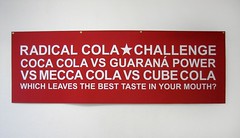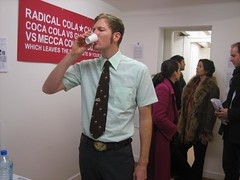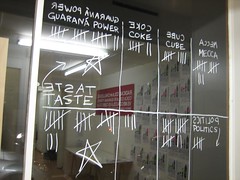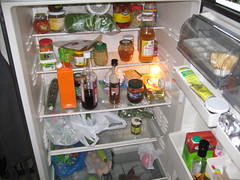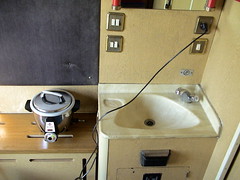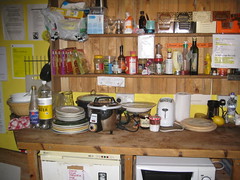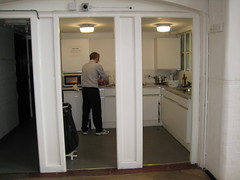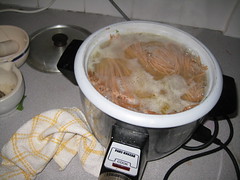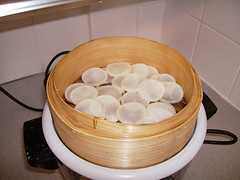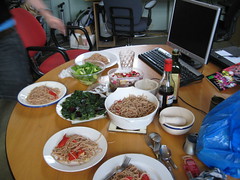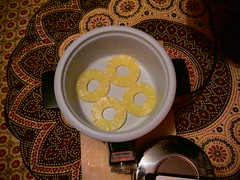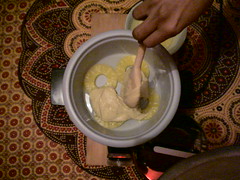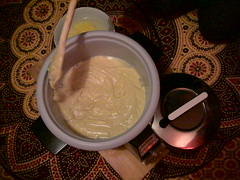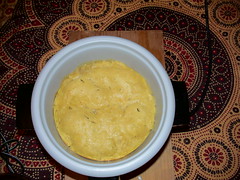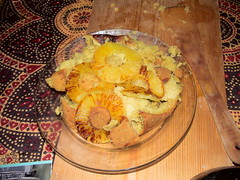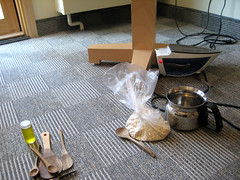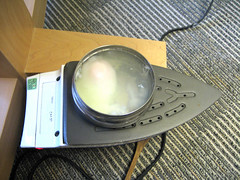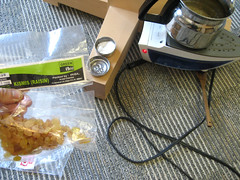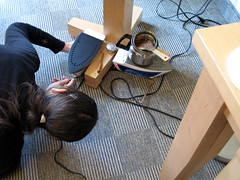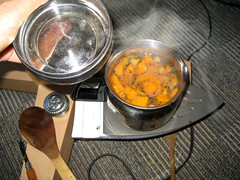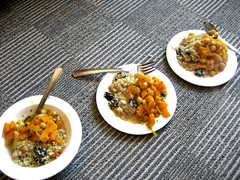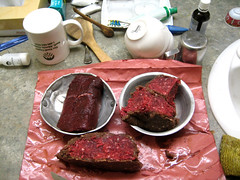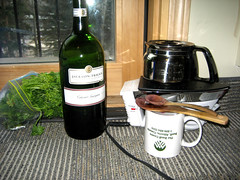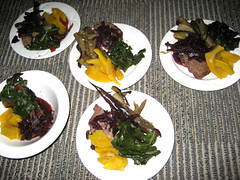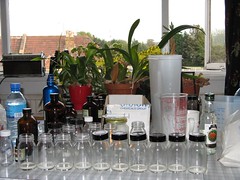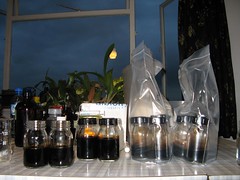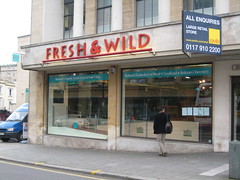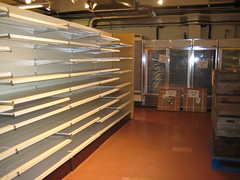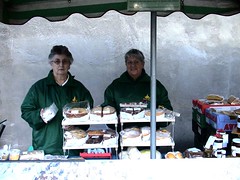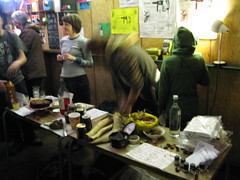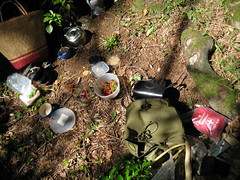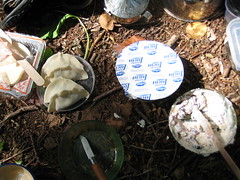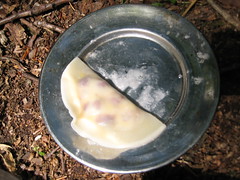recipes for disaster
Feral Trade Research
The Feral Trade project has been trading groceries, sourced and circulated outside commercial systems, for the past 6 years. The project uses peer to peer protocols like the social protocols of email, to maintain an artist-run grocery business outside the motives of the market. An online courier database http://www.feraltrade.org provides a navigable interface to the network.
While not a propositional model for a viable large scale operation, the project maintains a functioning alternate freight system for groceries and other goods to travel internationally. Feral Trade supplies a drifting network of individuals (friends, colleagues, other artists, their family members and social contacts) and organisations (including former and prospective employers, sponsors, hosts and organisational peers). The challenge of supplying groceries to the art world in particular, has led to an interest in the Public Diet of cultural organisations: the proposition that it's the disassociation between content - beliefs, ideals, curated programmes of events - and infrastructure - context, economy, service utilities, the things you handle and systems you subscribe to - that has brought us to the current twin towers of economic & ecological collapse.
Taste
The Radical Cola Challenge is an artwork by San Francisco artist Amy Balkin, originally exhibited at commercial gallery Analix Forever in Geneva, 2006 (http://sparror.cubecinema.com/cube/cola/service/geneva_radical_cola_challenge). The work took the form of a blind tasting of four different cola drinks (Coca-Cola, Mecca-Cola, Cube-Cola and Guarana Power) alongside each product's manifesto. Gallery visitors then selected which drink's ideology they preferred VS which drink they found the tastiest, to see if their politics and aesthetics would align (they didn't).
Public Diet
The Public Diet is defined here as the quandary of how to reconcile the remit of your organisation with the organisation of your fridge. How we present and perpetuate ourselves as organisations via culinary means: office lunch, public hosting, event catering, kitchen strategies and shopping for ingredients - and the continuity (or otherwise) of that interface with other dialogues. Whilst workshopping these ideas in the ultra hospitable environment of FoAM, the longterm intent is to feed the findings up to challenge larger, more sedentary entities such as major museums or cultural centres.
Persistence
One of the issues the research raises is the value of persistence in the art world. Feral Trade has made repeated attempts to enter the food chain of other institutions as a vendor, with variable results. This supplier-style relationship, with its repeat cycle of orders, delivery and invoicing, breaks with the art world's natural currency of novelty. While event-based spectacles such as the one-off exhibition and service of Feral Trade coffee have been easy to negotiate, attempts at sustained engagement with the infrastructure have met with relative inertia (see http://www.feraltrade.org/cgi-bin/shipments/2shipping.pl?action=list_shipments&viewall=1&new_sort=sendloc&criterion=V%26A for a rare instance of success).
THE RESEARCH
The Public Diet research was conducted as a series of experiments carried out in my own natural environs, as applied catering experiments for moving artists and stationary institutions.
Nutrition for Artists
The often depleted environs encountered by the contemporary arts practitioner, nomadic in pursuit of its trade, include hotels, transportation and waiting rooms. As for other itinerant workers, nutrition is vital to maintain currency in a market of freelance employment, intensive hours and frequent travel.
EXPERIMENT 1: Ricecookers from Iran
In 2005, Berlin artist Natascha Sadr-Haghighian and I imported 25 electric ricecookers to UK and Germany from their factory source in Iran, and distributed them to a network of subscribers. Social and family connections helped negotiate the direct export from the Pars Khazar ricecooker factory. The import was designed to enlarge the options for basic cooked foods where self-catering is otherwise unavailable.
Ricecookers can provide basic portable nutrition in a range of territories. For hospitality and sustenance you just add water, rice and electricity. A ricecooker works fine on the train - for example a sleeper compartment across Bulgaria - also at laptop and vacuum-cleaner sockets at other semi-public spaces such as airport lounges. To cook espresso just remove the inner pot and place espresso pot directly in the heating element.
The ricecooker is also good in fixed contexts such as office lunch and event catering within cultural institutions. The menu can go way beyond rice to anything that needs heating.
At the Cube Microplex, Bristol, staff eat basmati rice from the local food co-op and Indian readymeals from the Asian supermarket on evening shifts. The sprawling all-volunteer staff makes an organised fresh food system difficult to manage but the readymeal range with rice is a good compromise for low price, shelf life, tastiness, range and relative nutrition. The ricecooker is also occasionally used for events, for example making steamed wontons at a music event.
Mute Magazine, London use their ricecooker daily along with a microwave, after building management ripped the stove out of their office kitchen a few years ago. Managing editor Simon Worthington has developed an office lunch menu with items such as risotto, spelt pasta with spinach, red peppers and beetroot, or daikon cod.
Polytechnic, Newcastle. Ricecooker pineapple upsidedown cake experiment with Sneha Solanki.
EXPERIMENT 2: Room Selfservice
The interfaces where artist and institution collide can show up the extremes of organised culture. Last winter I flew from a two month residency in Bangladesh direct to a one month placement at the Banff Centre, Canada. The Room Selfservice experiment was an attempt to reconcile wildly disparate belief systems, in the rapid transit from self/family-based subsistence catering to the institutional buffet. It raises the question of survival in the hostile terrain of organised hospitality - the hotel room - where most of the means of subsistence such as cleaning products have been confiscated. Using available equipment (mini coffee filter machine, the in-room iron) cooking progressed from the poached egg through lunch service to hosting banquets. Extra cooking equipment was invited in from other guests' rooms, with plates etc borrowed from the buffet area, plus a few cooking implements brought from Bangladesh. The final game dinner featured moose and elk, delivered frozen in small packets by Banff New Media Centre director (friend of the meats' hunter) and prepared on the hotel room bathroom counter.
EXPERIMENT 3: Institutional Trade
Cube-Cola, a cola manufacturing collaboration with Kayle Brandon, shows how a major beverage can be produced and distributed out of a small cinema. Using an open source recipe developed over four years and an accumulated store of equipment, ingredients and supplier relations, we have found ourselves to be world-leading open source cola developers. Cube-Cola has worldwide distribution in concentrate form via internet order, paypal, hand baggage and mail. External media attention (newspapers and blogs) keeps the project publicly active without any need for publicity or marketing - although sales at this scale only generate enough cash to cover ingredient and equipment costs. A batch of concencentrate taking approximately 2 hours to prepare will make up around 120 litres of cola. An advantage of the project is our own independence from the beverage mainstream - with a 6-month inventory of ingredients, even a carbonation plan - should other softdrink supply lines should fail.
Disaster
The aesthetics of emergency and survival have more normally been monopolised by other interests: the military, outdoor adventure catalogues, NASA, or memories of WWII (hoarding flour, eggs, lard etc). The above techniques for alternate emergency provisioning have been rehearsed from position of luxury (IE. choice), although as training they could be prescient. The collapse of the Bristol flagship store of Fresh and Wild in September 2008 - a luxury foods supermarket in Bristol owned by the US giant Wholefoods, whose core values include creating wealth through profits & growth - signals a singular tremor in the fine food market.
In Fresh and Wild's absence, more inspiring suppliers in Bristol include the Womens Institute - a UK rebel network of highly organised cake and scone makers. And November 2008's Cube-Cola Producers' Party at the Cube brought its own network of local low-quantity provisioners (nettle beer, damson vodka, wild jams) out of the woodwork. Although it is interesting to note though that many of these home-manufactured, foraged, baked, brewed and crafted food suppliers - including Cube-Cola - cluster around the common mass-market commodity of refined sugar.
EXPERIMENT 4: Outside Catering: sustaining culture without kitchens or buildings.
Photos show Castle Park cherry and cheese pierogis supplied for the Cube Outdoors Riverxing Exercise (Bristol); and unlicensed sandal espresso stand at a northern England food fair (Gateshead).

